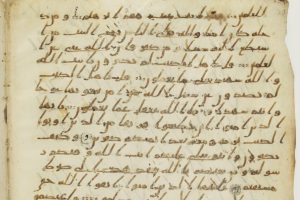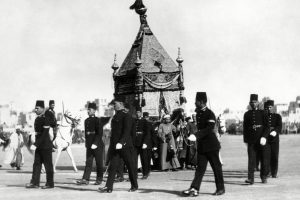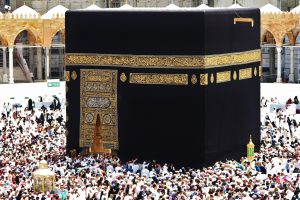
“And proclaim unto men the pilgrimage. They will come to thee on foot, and on every lean camel, coming by every distant, deep track.”[1]
Deep in the heart of the Arab Peninsula, amidst the desert and the valleys of Pharan, stands a modest bricked structure, the Holy Ka’bah. Though extremely simple and plain in its appearance, for centuries it has served as one of the most holy and significant sites in the history of mankind.
The Holy Ka’bah is the first ever house built for the worship of God, it has existed even before Abraham’sas time and was, in fact, built in prehistoric times. It was established for the benefit of the whole of mankind, to act as a centre for the unification of humanity.
It has attracted pilgrims from across the world for thousands of years, performing various rituals and rites in the remembrance of their Creator. However, with the lapse of time, the world failed to recognise its grandeur, and by the 5th century AD it had become the centre of idol-worship. As idolatry spread through Arabia, Pilgrimage to the Ka’bah lost its purpose and purity. Men and women would perform the circuits around the Holy Ka’bah naked, the sacred prayers and the holy practice of the prophets, were reduced to a series of hand clapping, whistling and blowing horns. The Ka’bah itself, which symbolised the oneness of God, was covered with paintings, poems and housed over three hundred-and-sixty idols.
Since the Ka’bah was originally built as the centre for all humanity, the House of Allah, again, was meant to become a centre for the unification of humanity through the emergence of the most perfect and immaculate universal teaching, revealed to the Holy Prophet Muhammadsa.
In the ninth year of Hijra, the Holy Prophetsa announced that he would lead the pilgrims himself to perform Hajj, the news quickly spread throughout Madinah and the surrounding desert tribes and they flocked in their multitudes for the blessed opportunity to accompany the Holy Prophetsa. And so, in the month of Dhul Hijja, the traditional month for Hajj, the Holy Prophetsa at the head of thirty thousand men and women set out from Madinah, for what was to become one of the most historical journeys for the whole of mankind.
On the fifth of Dhul Hijja, upon reaching the outskirts of Mecca, the Holy Prophetsa began to repeat the ancient cry of the pilgrims:
“Here am I, O Allah, here am I; Here am I, there is no associate with Thee; All praise is Thine and all Bounty; There is no associate with Thee.”
After entering the holy city of Makkah, the Holy Prophetsa performed the various rituals of Hajj, once again reviving the sacred precincts of the Ka’bah and whilst he restored the sanctity of the pilgrimage, he attached new meaning and significance to the rituals that had become distorted by the pagan traditions, Hajj once again symbolised the centre of unity and for the worship of God Almighty.
There are two central principals in Islam that form the basis of all its teachings; fulfilling the rights of God and secondly the rights towards one’s fellow beings. The Founder of the Ahmadiyya Muslim Community, Hazrat Mirza Ghulam Ahmadas, the Promised Messiah and Mahdi writes, “I admonish you to adhere to two primary principles: keep your affairs with Allah on the straight path, and treat the human beings with sympathy and good manners.”[2]
Hajj epitomises both of these values and grants the pilgrim a perfect opportunity to experience and inculcate these values within himself.
The Promised Messiahas in his book, Chashma-e-Ma’rfat (Fountainhead of Divine Insight) states that worship comprises of two aspects. One, is of humility and fervency which is observed in one’s Salat (prayer) whilst the other is an expression of immense love and passion and this is reflected in the various rituals and rites performed by the pilgrim during Hajj. Shedding off all excessive garments baring two simple white cloths (Ihram), circumambulating the Holy Ka’bah (Tawaf), running between Safa and Marwah (Sai), kissing the Black Stone (Hajre Aswad) are all performed as a result of this deep emotion of love.[3]
The Promised Messiahas further states that the body and soul are deeply intertwined, and the body’s physical actions deeply impact the soul and vice versa. Expounding on this in his book, The Philosophy of the Teachings of Islam, he writes:
“The design of the Almighty Who has created the soul from the body with His perfect power appears to be that the second birth of the soul should also take place through the body. The movements of the soul follow the movements of the body. If the body is drawn in a particular direction the soul automatically follows it. It is, therefore, a function of the Book of God to direct itself to the natural state of man: that is why the Holy Qur’an pays so much attention to the reform of the natural state of man and gives directions with regards to everyone of his actions […] It affirms that man’s physical condition affects his spiritual condition deeply.”[4]
The rituals and rites performed during Hajj may seem rather strange or unusual to an outsider, however they create a feeling of such deep emotion of love within the believer that he has never experienced before. It is absolute love at its peak.
The second principal of Islam relates to mankind and inculcating love and sympathy within the believers. The Promised Messiahas writes:
“The teachings of the Holy Qur’an can be divided into two major categories. The first being unity of God, love and obedience to Him. The second is to treat kindly your brothers and fellow beings […] be kind and merciful to humanity […] always work for the good of mankind.”[5]
This second core aspect of the Islamic teaching is also a major theme that is covered in the institution of Hajj for it grants the pilgrims a unique opportunity to experience the unity of mankind at such a tremendous scale, the likes of which are unparalleled in any other religion.
The vast ocean of pilgrims are drawn from across the globe; people of all countries and all races join together in a bond of brotherhood, clad in two simple pieces of cloth; class status and vanity is all but eliminated. As they circulate the House of God they represent small particles that gradually merge into one body, master and servant, friend and foe, king and subject stand equally, shoulder to shoulder in front of the Sacred House, repeating; “Here am I, O Allah, here am I; Here am I, there is no associate with Thee; All praise is Thine and all Bounty; There is no associate with Thee.”
The Holy Prophetsa, throughout his life laid great emphasises on the importance of living as one connected and loving community, he said:
“The believers, in their love, mutual kindness, and close ties, are like one body; when any part complains, the whole body responds to it with wakefulness and fever.”
And, “The faithful are like one man: if his eyes suffer, his whole body suffers.” He further stated, “The Faithful are to one another like [parts of] a building – each part strengthening the others.”[6]
Hajj draws pilgrims from across the world and provides the perfect opportunity to practically experience and demonstrate the ideals set forth by Islam for a united and harmonious society.
With regards to this unique aspect of Hajj, the Promised Messiahas says:
“Allah desires to make all mankind as if they were all one person. This could also be called a democratic singularity. Under this concept the diverse mankind could be considered as one individual. The purpose of religion is also that the human race be united in the form of the beads of a Tasbeeh (rosary) through one thread.
The congregational prayers or Salat is also for such unification so that all the worshipers are counted as one. The reason why we are prescribed to stand shoulder to shoulder is so that whoever has greater wisdom or spiritual charisma is able to influence the weak. It is hoped that spiritual influence of the wise will diffuse into the weak. The Hajj is also for the same plan.
Allah started the plan of democratic singularity by instructing that all Muslims of a locality should say the five prayers in congregation in the local mosque. So that the moral qualities can be exchanged and the wisdom and light replaces weaknesses. By such interaction Muslims are introduced to each other and develop affection for each other. Such introduction is very important as that leads to affection which is the basis of the unification.
[…] The second Divine instruction is that on Friday for the Friday prayer Muslims should gather in the main mosque of the township. It is hard for all the people of the town to get together on a daily basis. Therefore, it was suggested that all the citizens of a town should at least weekly get acquainted with each other and promote unity. By such a scheme, eventually, all of them will unite in one body or singularity. Then on an annual basis Allah has prescribed that the Eid prayers be said at a regional level so that acquaintance and affection grows wider and helps in the process of democratic singularity.

In the same theme, for the unity of the whole world, Allah has prescribed, to perform Hajj at least once in one’s lifetime so that representatives of all people assemble together in the expanse of Makkah. In summary this is Allah’s desire that affection and love among mankind progresses.”[7]
Hajj is an extremely important Islamic institution, a highly emotional experience that entails great benefits. The Holy Qur’an has devoted a whole a chapter, Surah Al-Hajj, explaining the various aspects and aims of this holy pilgrimage.
In his commentary (Tafseer-e-Kabir) of this Surah, Hazrat Mirza Bashiruddin Mahmud Ahmadra the Second Khalifah of the Ahmadiyya Muslim Community, expounding on the social significance of Hajj writes:
“Apart from the spiritual good that the Pilgrimage does to a Muslim, it possesses a great social and political significance. It has great potentialities for wielding different Muslim countries into one strong international brotherhood of Islam. Muslims from all parts of the world who meet at Mecca once a year can exchange views on all sorts of matters of international importance, renew old and establish new contracts. They have opportunities to acquaint themselves with problems that confront their brethren in Faith in other countries, to copy one another’s good points and profit by one another’s experience and also to co-operate with one another in many other ways. Mecca being God’s appointed centre of Islam, the Pilgrimage can serve as a sort of United Nations Organization for the whole Muslim world.”[8]
The last pilgrimage of the Holy Prophetsa exemplifies the grand and lofty objectives of Hajj. It was during this pilgrimage that the Holy Prophetsa delivered his historic sermon, famously known as the Farewell Sermon. It was the eleventh of Dhul Hijja, just after the sun had passed its zenith, addressing the thousands who had assembled from all over Arabia to be in the blessed company of their messenger, he reminded them their duty towards mankind. He preached to them to remember that all humans are equal to one another, to deal justly, to treat women as kindly as possible and end all bloodshed.
In conclusion, he said: “What I command you today is not only meant for today. It is meant for all time. You are expected to remember it and act upon it until you leave this world and go to the next to meet your Maker […] What I have said to you, you should communicate to the ends of the earth. Maybe those who have not heard me may benefit by it more than those who have heard.”
Today, millions of Muslims converge in the Holy city of Mecca, travelling by land, sea and air from all corners of the earth. Responding to the call of God, a pilgrim discards all comforts and luxuries the world has to offer, laying aside all worldly affairs, he embarks upon this spiritual journey to the land that has throughout man’s history witnessed the manifestation of God’s love and God’s blessings. They stand as one community, with one God, one Religion, one Prophetsa and one Book, with the Ka’bah as the one spiritual centre for the whole of mankind.[9]
Shahzad Ahmad is on the Editorial Board of The Review of Religions. He has regularly appeared on ‘Beacon of Truth’ on MTA International.
Endnotes
1. Holy Qur’an, Surah Al-Hajj, Verse 28.
2. Malfoozat, Vol.9, p.35.
3. Chashma e Mar’fat, Ruhani Khazain, Vol. 23, pp. 99-101.
4. The Philosophy of the Teachings of Islam (Tilford, Surrey: Islam International Publication, 1996), p.8.
5. Nasim Rehmatullah, “Service to Mankind is the Essence of Islam”, Al Islam, 1999, https://www.alislam.org/library/articles/new/service-to-humanity.html.
6. “The Believers Are Like One Body”, In Pursuit of Peace, June 2, 2012, https://dunyatodeen.wordpress.com/2012/06/02/the-believers-are-like-one-body/.
7. Malfoozat, Vol.4, p.100.
8. Holy Qur’an, Surah Al Hajj, Verse 28.
9. Hazrat Mirza Bashiruddin Mahmud Ahmadra, Life of Muhamadsa (Tilford, Surrey: Islam International Publication, 2013), pp. 184-185.




Add Comment